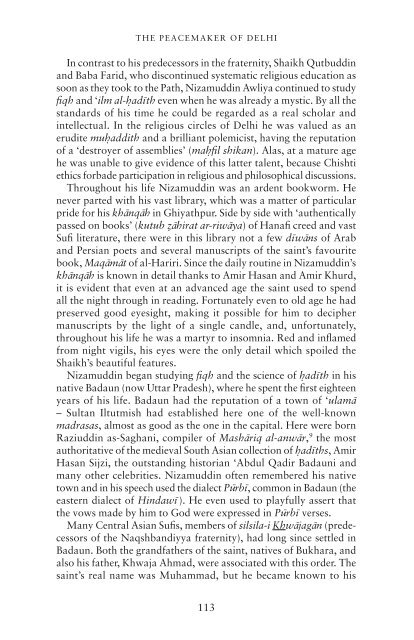Muslim Saints of South Asia: The eleventh to ... - blog blog blog
Muslim Saints of South Asia: The eleventh to ... - blog blog blog
Muslim Saints of South Asia: The eleventh to ... - blog blog blog
You also want an ePaper? Increase the reach of your titles
YUMPU automatically turns print PDFs into web optimized ePapers that Google loves.
THE PEACEMAKER OF DELHI<br />
In contrast <strong>to</strong> his predecessors in the fraternity, Shaikh Qutbuddin<br />
and Baba Farid, who discontinued systematic religious education as<br />
soon as they <strong>to</strong>ok <strong>to</strong> the Path, Nizamuddin Awliya continued <strong>to</strong> study<br />
fiqh and ‘ilm al-h˝adīth even when he was already a mystic. By all the<br />
standards <strong>of</strong> his time he could be regarded as a real scholar and<br />
intellectual. In the religious circles <strong>of</strong> Delhi he was valued as an<br />
erudite muh˝addith and a brilliant polemicist, having the reputation<br />
<strong>of</strong> a ‘destroyer <strong>of</strong> assemblies’ (mah˝fil shikan). Alas, at a mature age<br />
he was unable <strong>to</strong> give evidence <strong>of</strong> this latter talent, because Chishti<br />
ethics forbade participation in religious and philosophical discussions.<br />
Throughout his life Nizamuddin was an ardent bookworm. He<br />
never parted with his vast library, which was a matter <strong>of</strong> particular<br />
pride for his khānqāh in Ghiyathpur. Side by side with ‘authentically<br />
passed on books’ (kutub z.āhirat ar-riwāya) <strong>of</strong> Hanafi creed and vast<br />
Sufi literature, there were in this library not a few dīwāns <strong>of</strong> Arab<br />
and Persian poets and several manuscripts <strong>of</strong> the saint’s favourite<br />
book, Maqāmāt <strong>of</strong> al-Hariri. Since the daily routine in Nizamuddin’s<br />
khānqāh is known in detail thanks <strong>to</strong> Amir Hasan and Amir Khurd,<br />
it is evident that even at an advanced age the saint used <strong>to</strong> spend<br />
all the night through in reading. Fortunately even <strong>to</strong> old age he had<br />
preserved good eyesight, making it possible for him <strong>to</strong> decipher<br />
manuscripts by the light <strong>of</strong> a single candle, and, unfortunately,<br />
throughout his life he was a martyr <strong>to</strong> insomnia. Red and inflamed<br />
from night vigils, his eyes were the only detail which spoiled the<br />
Shaikh’s beautiful features.<br />
Nizamuddin began studying fiqh and the science <strong>of</strong> h˝adīth in his<br />
native Badaun (now Uttar Pradesh), where he spent the first eighteen<br />
years <strong>of</strong> his life. Badaun had the reputation <strong>of</strong> a <strong>to</strong>wn <strong>of</strong> ‘ulamā<br />
– Sultan Iltutmish had established here one <strong>of</strong> the well-known<br />
madrasas, almost as good as the one in the capital. Here were born<br />
Raziuddin as-Saghani, compiler <strong>of</strong> Mashāriq al-anwār, 9 the most<br />
authoritative <strong>of</strong> the medieval <strong>South</strong> <strong>Asia</strong>n collection <strong>of</strong> h˝adīths, Amir<br />
Hasan Sijzi, the outstanding his<strong>to</strong>rian ‘Abdul Qadir Badauni and<br />
many other celebrities. Nizamuddin <strong>of</strong>ten remembered his native<br />
<strong>to</strong>wn and in his speech used the dialect Pūrbī, common in Badaun (the<br />
eastern dialect <strong>of</strong> Hindawī ). He even used <strong>to</strong> playfully assert that<br />
the vows made by him <strong>to</strong> God were expressed in Pūrbī verses.<br />
Many Central <strong>Asia</strong>n Sufis, members <strong>of</strong> silsila-i Khwājagān (predecessors<br />
<strong>of</strong> the Naqshbandiyya fraternity), had long since settled in<br />
Badaun. Both the grandfathers <strong>of</strong> the saint, natives <strong>of</strong> Bukhara, and<br />
also his father, Khwaja Ahmad, were associated with this order. <strong>The</strong><br />
saint’s real name was Muhammad, but he became known <strong>to</strong> his<br />
113


